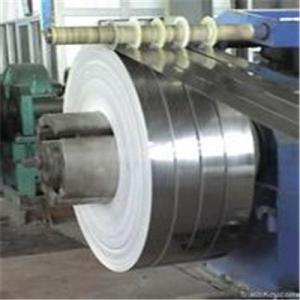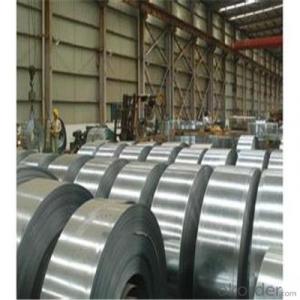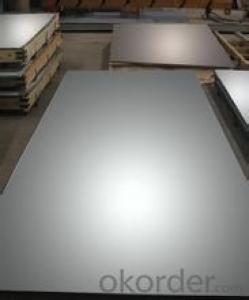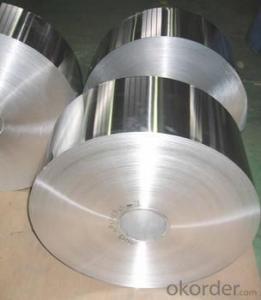Hot -dip Galvanized Steel Strip Coils Professional Manufacturer in China
- Loading Port:
- Shanghai
- Payment Terms:
- TT OR LC
- Min Order Qty:
- 22 m.t.
- Supply Capability:
- 4433222 m.t./month
OKorder Service Pledge
OKorder Financial Service
You Might Also Like
Item specifice
Applications of Steel Strip Coils:
1:Chemical industry equipment, Industrial tanks
2:Medical Instruments,Tableware, Kitchen utensil,kitchen ware
3:Architectural purpose, Milk & Food processing facilities
4:Hospital Equipment, interior Exterior decoration for building
5:Architectural purposes, escalators, kitchen ware,vehicles
Festures of Steel Strip Coils:
Standards: Q195 SGCC DX51D
Other steel grade can be provided after negotiating with customers.
Size: thickness 0.08-5mm, width 10-950mm
Packing: Seaworthy packing.
Specifications of Steel Strip Coils:
| Description | Hot Rolled Steel Strip |
| Brand | Tianjin Metallurgical No.Steel Group |
| Specification | 1.2-6.0mm*70mm |
| Standard | AISI,ASTM,BS,DIN,GB,JIS |
| Material | Q195,Q215,Q215B,Q235,Q235B |
| Application | Widly used in welding steel pipes, and bicycle making etc. |
| Certificates | BV,SGS,ISO etc. |
| MOQ | 20 tons or according to customers’ requirement. |
| Port of Delivery | Tianjin Port of China |
| Remarks | We can provide qualify goods,competitive price and speedy delivery |
Images of Steel Strip Coils:

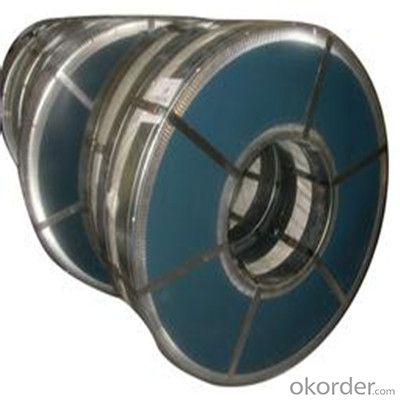
FAQ
1.What's your MOQ?
25MT, it is for one container.
2.Do you have QC teams?
Yeah, sure, our QC team is very important, they will keep the quality control for our products.
3. What's your normal delivery time?
Our delivery time about 10-20days for standard sizes, if you have other requirements like hardness and width ,it is about 20-40days.
- Q:What are the common defects found in steel strips?
- Some common defects found in steel strips include surface scratches, rust or corrosion, uneven thickness, edge cracks, and waviness.
- Q:How do steel strips perform under high temperatures?
- Steel strips generally perform well under high temperatures. Steel is known for its high melting point, which ranges from 1370°C to 1520°C (2500°F to 2750°F), depending on the specific type of steel. This means that steel strips can withstand extremely high temperatures without melting or losing their structural integrity. At elevated temperatures, steel strips also exhibit good thermal stability. They have a low thermal expansion coefficient, which means they expand and contract less compared to other materials. This property helps prevent warping or deformation of the strips when exposed to high temperatures. Steel strips also possess excellent strength and hardness even at elevated temperatures. While the strength of steel decreases slightly as temperatures rise, it still remains much stronger than many other materials. This makes steel strips suitable for applications where high temperature resistance and mechanical strength are essential, such as in furnaces, boilers, and heat exchangers. However, it is important to note that prolonged exposure to extremely high temperatures can lead to some changes in the properties of steel strips. At very high temperatures, steel can undergo oxidation or scaling, which may result in a loss of surface quality or corrosion resistance. Additionally, repeated heating and cooling cycles can lead to thermal fatigue, causing the steel to become more brittle over time. Therefore, it is necessary to consider these factors and choose the appropriate steel grade and surface treatment to ensure optimal performance under high temperature conditions.
- Q:What are the main challenges in handling and storing steel strips?
- The main challenges in handling and storing steel strips include their weight and size, susceptibility to corrosion, proper stacking and storage techniques, and maintaining a controlled environment to prevent damage.
- Q:How are steel strips cleaned before further processing?
- Steel strips are typically cleaned before further processing through a combination of mechanical and chemical methods. This involves removing any dirt, oil, grease, or other contaminants from the surface of the strips. Mechanical methods such as brushing, scraping, or blasting are used to physically remove debris, while chemical methods like pickling or degreasing are employed to dissolve and remove any residual oils or greases. Once the strips are thoroughly cleaned, they can undergo various further processing steps, such as coating, galvanizing, or rolling.
- Q:Can steel strips be used in agricultural irrigation systems?
- Yes, steel strips can be used in agricultural irrigation systems. They can be used as supports or brackets to hold pipes or hoses in place and provide stability to the irrigation system. Steel strips are durable, resistant to rust and corrosion, and can withstand harsh weather conditions, making them suitable for use in agricultural irrigation systems.
- Q:What is the thickness range of a steel strip?
- The specific application and manufacturing process contribute to the variability in the thickness range of a steel strip. Typically, steel strips span from extremely thin, measuring approximately 0.001 inches (0.0254 mm), to considerably thicker strips reaching several inches in thickness. The intended use in industries like construction, automotive, or manufacturing dictates the required thickness of the steel strip.
- Q:How are steel strips processed for insulation?
- Steel strips are processed for insulation through a series of steps to ensure maximum effectiveness and durability. Firstly, the steel strips are cleaned and degreased to remove any impurities or contaminants that may hinder the insulation process. This is usually done through a combination of chemical baths and mechanical cleaning methods. Once the steel strips are clean, they are then coated with a layer of insulation material. This can be done using various methods such as hot-dip galvanizing, where the steel strips are immersed in a bath of molten zinc, or by applying a layer of epoxy or polyurethane coating. These insulation materials provide a protective barrier against heat, moisture, and external elements, preventing corrosion and enhancing the thermal efficiency of the steel strips. After the initial insulation coating, the steel strips may undergo further processing depending on the specific requirements. This can include additional layers of insulation material, such as polyethylene or PVC, which provide added protection and insulation properties. The steel strips may also be subjected to heat treatment processes to enhance their mechanical properties and improve their resistance to wear and tear. Finally, the insulated steel strips are typically inspected for quality assurance before being packaged and shipped to their intended destination. This involves checking for proper insulation coverage, thickness, adhesion, and overall coating integrity. Various testing methods such as visual inspection, adhesion tests, and thickness measurements are employed to ensure that the insulation meets the required standards and specifications. In summary, the processing of steel strips for insulation involves cleaning, coating with insulation materials, additional layers if necessary, heat treatment, and quality inspection. These processes are crucial in ensuring that the steel strips are effectively insulated and protected, making them suitable for various applications in industries such as construction, automotive, and electrical.
- Q:What are the common sizes of steel strips?
- Sizes of steel strips can vary depending on the specific application and industry they are used in. However, there are standard sizes that are commonly used across different industries. For instance, in the automotive industry, steel strips are frequently available in thicknesses of 0.5mm, 0.8mm, 1mm, and 1.2mm, with widths ranging from 25mm to 150mm. These sizes are commonly utilized for manufacturing brackets, clips, and reinforcements. In the construction industry, steel strips are commonly found in thicknesses of 1.5mm, 2mm, and 3mm, with widths ranging from 20mm to 150mm. These sizes are often employed for framing, support structures, and cladding. In general, steel strips can be found in a range of thicknesses from 0.5mm to 5mm, and widths that typically span from 10mm to 300mm. The specific size and dimensions required will depend on the intended use and industry standards.
- Q:Can steel strips be used in electrical conductors?
- Yes, steel strips can be used in electrical conductors, but they are not typically preferred due to their high electrical resistance compared to other metals like copper or aluminum.
- Q:What are the main factors affecting the magnetic properties of steel strips?
- The main factors affecting the magnetic properties of steel strips include the composition of the steel, the heat treatment process, the presence of impurities or alloying elements, the grain size and orientation, and the magnetic field intensity applied during processing.
1. Manufacturer Overview |
|
|---|---|
| Location | |
| Year Established | |
| Annual Output Value | |
| Main Markets | |
| Company Certifications | |
2. Manufacturer Certificates |
|
|---|---|
| a) Certification Name | |
| Range | |
| Reference | |
| Validity Period | |
3. Manufacturer Capability |
|
|---|---|
| a)Trade Capacity | |
| Nearest Port | |
| Export Percentage | |
| No.of Employees in Trade Department | |
| Language Spoken: | |
| b)Factory Information | |
| Factory Size: | |
| No. of Production Lines | |
| Contract Manufacturing | |
| Product Price Range | |
Send your message to us
Hot -dip Galvanized Steel Strip Coils Professional Manufacturer in China
- Loading Port:
- Shanghai
- Payment Terms:
- TT OR LC
- Min Order Qty:
- 22 m.t.
- Supply Capability:
- 4433222 m.t./month
OKorder Service Pledge
OKorder Financial Service
Similar products
New products
Hot products
Related keywords
